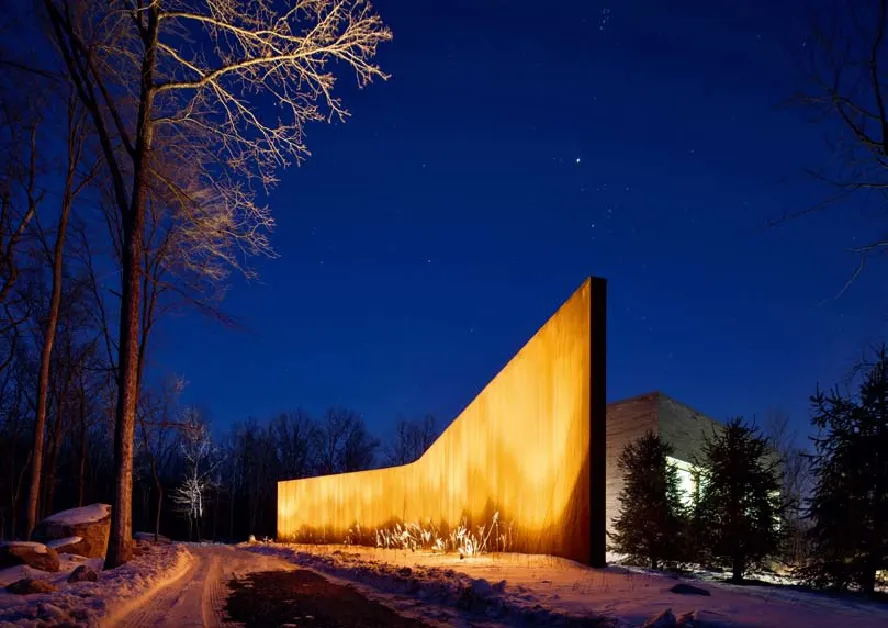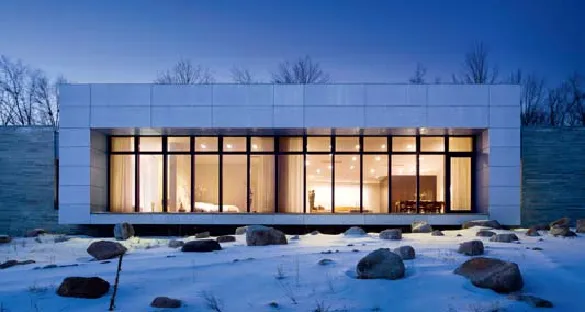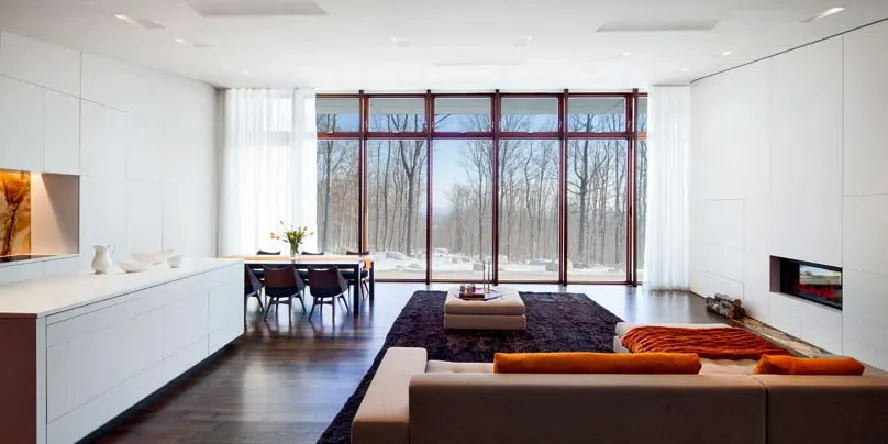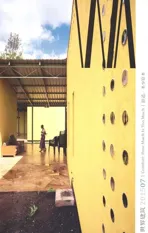林间小屋,阿斯特,纽约,美国
2015-12-22建筑设计威廉罗伊厄威廉罗伊厄建筑事务所
建筑设计:威廉·罗伊厄/威廉·罗伊厄建筑事务所
林间小屋,阿斯特,纽约,美国
建筑设计:威廉·罗伊厄/威廉·罗伊厄建筑事务所

1 西立面的耐候钢墙/Corten wall at west elevation

2 总平面/Site plan
林间小屋是一座独户住宅,它位于美国纽约阿斯特县肖瓦岗山脚下一片3.4hm2的密林中。这座446m2的住宅设计思考了两个对立几何形态的关系:一道披着耐候钢板的雕塑般的墙,以及仿佛从布满卵石的地面上浮现出来的大量分层青石。天然材料的运用和策略性的选址使得这座住宅能完全隐身于外部世界,同时也能紧密地与自然界相关联。
基地边界被77棵挪威云杉排成一排划分出来,这种奇特的元素把访问者引导至与世隔绝的入口。住宅中有一道弯曲墙体,充满英雄气质,同时又具有实用主义的合理性。它轻微的弯折创造出一个浅浅的入口庭院,同时也放大了这条通往住宅的小溪的流水声。另外,这道弯曲的墙犹如脊椎一样,把室内空间组织成一系列如观赏影片般观看周围景观的入口,每个窗户都形成一个特殊的视角,随季节影响着室内空间的性格。
这座住宅的室内空间是对质朴与收敛的实践。室内设计的材料选择来自房主的委托,要与她关于简洁、舒适、耐久的价值观保持一致。但这种鲜明而简素的审美观又被建材的丰富所调和,生成精致而经典的适居状态。
为了与房主关于环境的想法保持一致,林间小屋的设计和施工都遵循了《绿色建筑评估体系》(LEED)的严格规定。这座建筑的高性能散热层由紧固连锁的355.6mm厚承重隔热板,以及用森林管理委员会认证的木材定制的4层玻璃窗构成。这座住宅还采用了一种直接交换的地热系统,以及可用于浇灌云杉的雨水回收系统,此外,还有许多其他的绿色建筑技术。屋顶结构配合太阳能光伏电池和未来风力涡轮机来设计,然而即使没有这两项设计,这座住宅也获得了LEED银奖,且在家庭能源评级系统中得到44分,比一座典型的新建住宅节省约56%的能耗。□(辛梦瑶 译)
项目信息/Credits and Data
客户/Client: Privacy
主持建筑师/Principal Architect: William Reue
设计团队/Project Team: James Teese, Jr.
结构设计/Structural Engineer: Ross Dalland, P.E.
设备设计/Mechanical Engineer: D'Antonio Consulting Engineers
LEED 顾问/LEED Consultant: Integral Building & Design
家庭自动化/Home Automation: Everglades Technology
木工制作/Cabinetry: Cabinets by Stanley
建筑面积/Floor Area: 446m²
设计时间/Design Period: 2012.03-2012.10
建造时间/Construction Period: 2012.11-2013.12
摄影/Photos: Steve Freihon


3.4 西南立面/Southeast elevation

5 西北立面的耐候钢墙/Corten wall at northwest elevation

6 文字被刻在室外青石上/Text carved in exterior bluestone

7 西立面/West elevation
A House in the Woods is a single-family home located on a densely forested 8.5 acre lot at the base of the Shawangunk Mountains in Ulster County. The 4800 ft² residence is the result of the studied relationship between two opposing geometries – a long sculptural wall clad in CorTen weathering steel and a mass of stratified bluestone that appears to have emerged from the boulder-strewn earth. The use of natural materials and strategic siting make the house completely invisible to the outside world and yet keep it very tightly stitched into the natural one.
The site boundary is defined by a row of 77 Norway spruces, the sole element that guides visitors to the entrance of the secluded property. The curved wall of the building is heroic, yet pragmatically justified. Its slight bend creates a shallow entry court and amplifies the sound of the small stream that runs parallel to the house. Additionally, the curved wall operates as a spine that organizes the interior spaces as a series of cinematic portals to the landscape, each window framing a particular view that impacts the character of the interior as the seasons change.
The interior of the house is an exercise of modesty and restraint. Material selections were based on the owner's mandate to develop an interior consistent with her values of simplicity, comfort, and durability. The boldness of the austere aesthetic is tempered by the richness of its materials, resulting in a refined and classic habitable composition.
Consistent with the owner's sense of environmental stewardship, the design and construction for A House in the Woods followed the rigorous guidelines of the Leadership in Energy and Environmental Design (LEED). The building's high performance thermal envelope consists of 14-inch-thick Structural Insulated Panels that tightly interlock and custom-designed quadruple pane windows constructed with FSC-certified wood. The house also employs a direct-exchange geothermal heating system, a rainwater harvesting system that irrigates the row of Norway Spruces, and many other "green" building technologies. The roof structure was designed to accommodate photo-voltaic panels and future wind turbines. However, even without these two features, the house was certified LEEDSilver and has a Home Energy Rating System (HERS) Index of 44 which is approximately 56% more energy efficient than a typical new home. □

8 主入口/Main entrance

9 平面/Floor plan

10 起居室/Living room
评论
丁力扬:面与体、封闭与通透、厚重与轻盈。从图纸来看,这座建筑仿佛不是典型的探索舒适度和建造消耗平衡的建筑,反而更像是一个追求构图和体量的传统现代主义风格住宅。不过,通过一番阅读,我们可以发现耐候钢板墙体和通透的玻璃窗其实还有超越形式风格层面的作用——它们并不是传统意义的墙和窗,其实主要起到了“建筑设备”组成的作用。不过,问题也在于此,就像是空调的室外机一样,它们只是“外挂”在建筑以外——这种独立于建筑存在的意义除了技术需要以外和建筑本体无关,尤其是那片墙完全可以剥离于建筑整体。因此,从有限的图片和说明看来,想要使得这种设计思路更有说服力的话,它们最好有超越“外挂建筑设备”层面的其他与建筑本身关系更为紧密的作用。
姜涌:用一道V型巨墙、锚固家于自然之中,从而使得回家的路变得如故事和诗歌般的起承转合,同时V型的形态很好地解决了车行交通、主次入口、客厅与餐厅厨房的过渡、主卧与其他卧室的空间分配、设备用房布置等一系列问题。
Comments
DING Liyang: Surface and volume, enclosure and transparency, massiveness and lightness…This project does not seem to be a typical exploration of the balance between comfort and construction consumption; rather, it is more like a classic modernist building in pursuit of composition and volume. However, on close examination of the drawings and other related materials, it becomes obvious that the CorTen weathering steel and large windows are not just walls and windows in a traditional sense. Actually, these architectural elements are attached to the building as 'mechanical equipment'. But, just like the exterior equipment of air-conditioning, these elements merely 'hang' on the wall –independent parts that could be totally detached from the building. Therefore, in order to make this type of design more compelling, such elements better go beyond their current function as 'hanging equipment' to gain more interaction with the building per se.
JIANG Yong: A V-shaped giant wall anchors the home in nature, hence the way home is rendered like a story with poetic shifts and turns. Meanwhile, the V-shape does an excellent job in solving such problems as automobile traffic, main and auxiliary entrances, transition from the sitting room to the dinning room and kitchen, spatial disposition of master and minor bedrooms, as well as arrangement of facility rooms.
A House in the Woods, Ulster, New York, USA, 2013
Architects: William Reue/William Reue Architecture


11.12 起居室/Living room

13 主卧卫生间/Master bath
